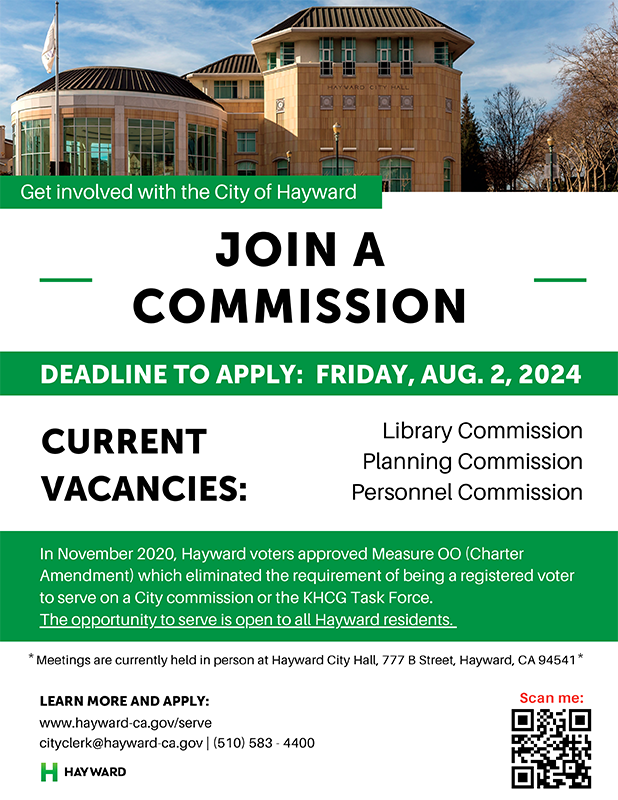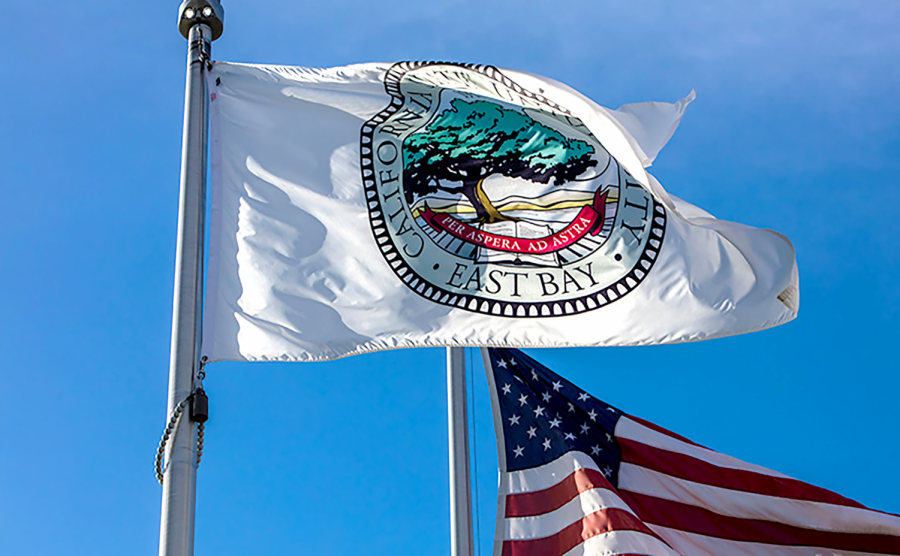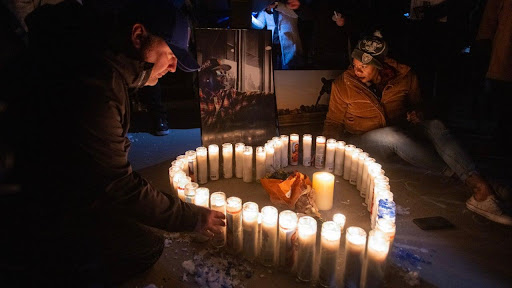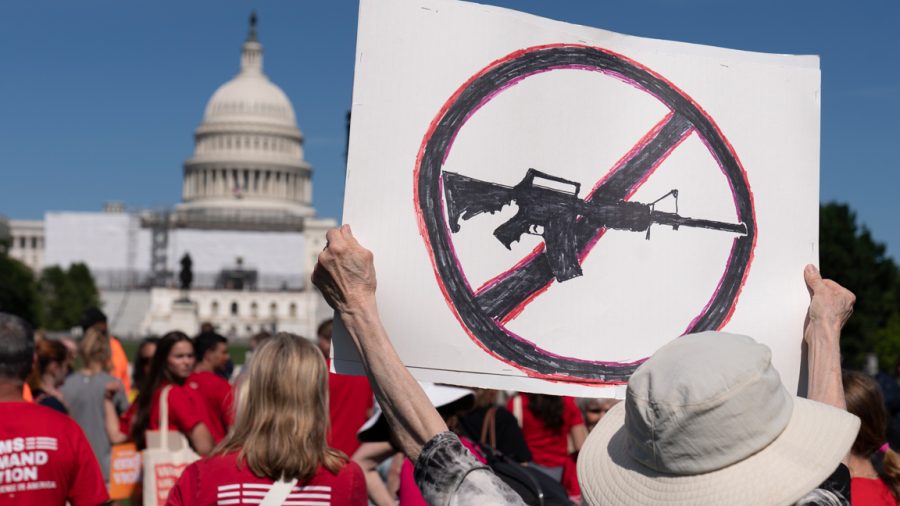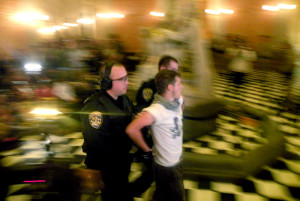 Sixty-eight protesters, including California university students, were arrested on Monday night in the capitol building in Sacramento after a day-long protest against education cuts and tuition fee increases. Students gathered this week in an effort to vocalize their struggle for education.
Sixty-eight protesters, including California university students, were arrested on Monday night in the capitol building in Sacramento after a day-long protest against education cuts and tuition fee increases. Students gathered this week in an effort to vocalize their struggle for education.
Protesters affiliated with the Occupy movement were arrested for trespassing, according to the California Highway Patrol, after they refused to leave the building after hours. The capitol building closed at 6 p.m. while the arrests were made at approximately 7:30 p.m.
Police representatives say officers at the scene told protesters repeatedly that they were in violation of state law by refusing to leave the grounds after hours and would be arrested if they did not comply.
No violence ensued as the arrested protesters peacefully walked out with police after a final warning was ignored.
Some chose to go limp, forcing officers to carry or drag them out of the building.
“We need to fight to refund education and we can do that physically with our bodies. Education is important for society to function,” UC Berkeley student Isaac Kreisman told The Pioneer briefly before his arrest.
“We have been shut out by the one percent and the only power we have is in our bodies and numbers. They say we are breaking the law, we say they are [breaking the law] by not allowing California to function.”
Those arrested were part of a larger march earlier in the day when thousands marched in Sacramento to protest education cuts and tuition fee increases; ending their march at the capitol building where members of legislature, students and teachers rallied and showed support for California education.
The protest, named “Occupy the Capitol,” was the result of a partnership between educational activist groups and Occupy participants.
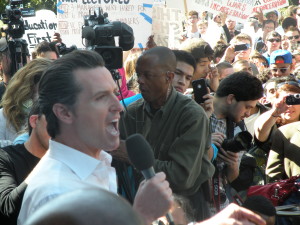
Students and educators from Los Angeles, Irvine, Riverside and the San Francisco Bay Area participated in the march. Unions and student organizations including the Alliance of Californians for Community Empowerment (ACCE) and ReFund California were present as well.
“We are sick and tired that we have been paying our taxes and not see education as a top priority. We want Gov. Brown and legislatures to make education the top priority in our state,” said Lino Pedres, a member of United Service Workers West.
“I think higher education is under attack, the cuts to UC, CSU and community colleges has been disproportionate compared to other state services,” said Miles Nevin, executive director of California State Student Association. “I think if we want to keep our promise to students and other people and help improve our state economy, then we need to reinvest [in education], I think it is vital to our state.”
With thousands of protesters convened on the capitol, state legislators took the opportunity to speak about recently proposed bills concerning education from book fees to education grants.
Assembly Majority Speaker, John A. Pérez, Senate President Pro Temp, Darrell Steinberg and Lt. Governor and former San Francisco mayor Gavin Newsom were among the elected officials who spoke to protesters.
Pérez gave a livid speech to protesters calling upon his scholarship plan as a hopeful means to give back to students.
Pérez’s plan would provide grants to students whose families make less than $150,000 a year in order to make college more affordable. Pérez claims this will cut college tuition fees by two-thirds through a billion dollar fund generated by closing the single sales factor tax.
Steinberg spoke of legislation and recent legislature changes as a positive and hopeful outcome for California education.
The senator proposed legislation last year to create an online source library to reduce the cost of course materials for college students.
Steinberg cited the passage of Proposition 25 on the 2010 ballot as a positive incentive to help fund education. The proposition ended the previous requirement that two-thirds of the members of California State Legislature had to vote in favor of the state’s budget in order for the budget to be enacted.
Steinberg told the crowd that education funding was now possible without what he calls “Republican obstructionism,” and advocated for Governor Brown’s fall tax proposal, which includes raising income tax on top earners and increasing sales tax by half a cent to generate funding for social services and education.
Newsom spoke to protesters, calling education cuts and fee increases unsustainable. He received much fanfare at the capitol with people swarming him for photos.
“I’ve been out speaking publicly and privately against these cuts but to no avail. I served formally on the CSU and UC board of regents and invariably we did what people knew we were going to do and that was increase tuition which I voted against every time,” Newsom told The Pioneer. “So I’m failing and I’m failing the students and I know that.”
Newsom called the Cal grant cuts inexcusable and said they disproportionately hurt African-Americans and Latinos in their pursuit of education.
“We are cutting into the artery and the system is beginning to bleed out and we need to do something about it,” said Newsom.
After the rally ended, hundreds of protesters and self-identified occupy participants filled the capitol building’s hall ways and the rotunda, decorating the room’s center piece statue with protester paraphernalia such as home-made signs and flyers with themes of anti-education cuts and tuition increases.
Protesters in the rotunda held a general assembly, a common method of proclaimed “direct democracy” by the Occupy movement where they voted on measures to protest for including democratizing the CSU board of trustees and UC board of regents, support a millionaire’s tax and ban standardized testing.
California Highway Patrol blocked off the rotunda to keep more from entering, leaving hundreds of other student protesters and occupy participants in the hallways, chanting and shouting in protest to education cuts.
Others spent their time lobbying for education bills. The split in protestor activities highlighted the difference between members of Occupy and those who preferred more traditional lobby and protest methods.
Andrew Sayed, a UC Irvine student and member of the University of California Student Association (UCSA), was waiting in the hallways for his chance to lobby to state legislatures.
“We don’t agree with the methods used by the Occupy movement, they need more organizing,” said Sayed. “We should talk to our legislature about what we really want and I think that is how we can really make change. But they [Occupy] do have a good cause and no one can blame them for being angry.”
Luz Calvo, chair of the Department of Ethnic Studies at CSU East Bay, disagreed with lobbying, calling it worthless because it has been done for years and accomplished little.
“They [members of state government] have to be more afraid of us, they have to be afraid of people shutting down the cities, the ports, and the capitol,” Calvo said. “Nothing will change unless there are people pushing from the outside.”




